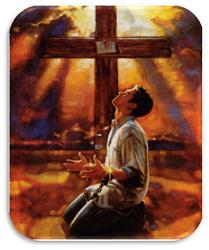Christ and the Identity of the Church
Christ and the Identity of the Church
The Lordship of Christ over His Church⤒🔗
It is difficult to find a stronger bond than the one between Christ and the church. The New Testament uses the imagery of head and body to indicate the importance of the Lord Jesus for the church.
 The church has various attributes – derived from the Bible – such as unity, holiness, catholicity, and apostolicity. Besides these we can distinguish more characteristic aspects in the life of the church. Multiple situations and circumstances can play a determining role, and this would also explain why there are all sorts of differences. Cultural, linguistic, historical, confessional, and even personal or political factors determine the organization, the atmosphere and image of a church community. All of this has a bearing in some way on the identity of a church.
The church has various attributes – derived from the Bible – such as unity, holiness, catholicity, and apostolicity. Besides these we can distinguish more characteristic aspects in the life of the church. Multiple situations and circumstances can play a determining role, and this would also explain why there are all sorts of differences. Cultural, linguistic, historical, confessional, and even personal or political factors determine the organization, the atmosphere and image of a church community. All of this has a bearing in some way on the identity of a church.
The essential identity of the church, however, is found in the relationship between Christ and the church. He is the Lord of the church. The underlying Greek word for church (kuriakè) is derived from the word “Kurios,” Lord. Church means “belonging to the Lord,” in the deepest sense of the word. That explains why this relationship means the most for the church’s identity. And then questions immediately arise.
If Christ is the head of his body, the church, we can compare this to the photo in our passport. That picture will clearly identify whether we are the person described or not. But that photo only represents about a fifth of our total length. And no one asks about the rest of us! The face is our portrait. That is sufficient.
The identity of the church rests in the lordship of Christ. What could be crucial in the church without him?
Two Levels of Identity←⤒🔗
We arrive here immediately at the question about the other factors in our church identity. These are human factors. Church history makes it clear which permanent marks have been left behind on the body of the church by reformers, pastors, kings, and also by errors, persecutions, political pressures, by economic setbacks, philosophical developments, and so much more. At times we recognize national characteristics in certain church regulations, liturgical matters, or even in confessional emphasis. And yet such churches recognize each other as true churches of God that share the same saving faith.
There is a historical problem in the manner wherewith separations between churches have taken place. Often the reasons were legitimate and clear. It was often affirmed in a clear way that separation was needed before God, and that obedience to him was at stake. Nevertheless, we always see that the development of a specific identity in a church community gives it its own “colour” distinct from that of other churches. On account of this it may be challenging, if not impossible, to rediscover the unity of former times.
When we analyze the characteristic features of a church we notice a few aspects that have a bearing on obedience to God’s Word and the lordship of Christ. However, there are also certain traits that are based on the actions and insights of people. There is nothing wrong with that, but it is well to distinguish the two different levels of identity. Not everything finds its origin in obedience to Christ, even if it is not in conflict with it!
We realize that in the meeting of representatives of Reformed and Presbyterian churches such differences too will come to light. We therefore need to dedicate ourselves in our mutual encounters to recognize what is truly the lordship of Christ and our obedience to him.
This explains why I wish to dig a little deeper into the significance of Christ’s government over his church.
Christ’s Threefold Office←⤒🔗
For the reflection on the offices of Christ, Calvin has made a great contribution. It was clear to him that we are not to think of three distinct functions of Christ, but of one office with three different aspects. Christ is our king, priest, and prophet. The three aspects of the work of Christ are indivisible. His work as our Saviour, as our Mediator, is one. In Christ the promises of the Anointed one are fulfilled, and that has to do primarily with God’s promise of an eternal kingship for David and his descendants (2 Sam. 7:12-16; 2 Kings 8:19). In that sense we have reason to mention Christ’s office as King and Lord in the first place, as long as we recognize that it is impossible to separate this from his work as High Priest and Prophet. His office as Redeemer of his people concerns one work. In the New Testament witness about Christ and his work, we repeatedly recognize the perspective of the Old Testament.
Even as Christ went down the path of humiliation, to carry our punishment, he remained King. He was King and Lord when he was mocked. He fulfilled what he had told his disciples, that the Son of Man had come not to be served, but to serve and to give his life as a ransom for many (Mark 10:45). In this way of abasing himself, his true kingship came to light, as faith knows. Our Lord and King was crucified. The route of Christ’s redemption, via the crucifixion on Golgotha, displays the fulfillment of God’s law over Israel’s King as we find it in Deuteronomy 17.
 Also in his exaltation we see the Lord Jesus as the same person he was before. At his ascension into heaven, while blessing his disciples, he showed his nail-marked hands. As Christ receives the highest glory in his reign over all and everything, as he allows world history to continue in accord with God’s plan, the name befits him not only as “the lion from the tribe of Judah” but also the name of “a lamb as slain” (Rev. 5:5, 6). What depths of unity between cross and glory! No royal victory without a priestly sacrifice.
Also in his exaltation we see the Lord Jesus as the same person he was before. At his ascension into heaven, while blessing his disciples, he showed his nail-marked hands. As Christ receives the highest glory in his reign over all and everything, as he allows world history to continue in accord with God’s plan, the name befits him not only as “the lion from the tribe of Judah” but also the name of “a lamb as slain” (Rev. 5:5, 6). What depths of unity between cross and glory! No royal victory without a priestly sacrifice.
For that reason the Lord of the church, also in his majesty, is recognized at the cross. Herman Bavinck once said that in Christ’s struggle against Satan, sin, and the world, the cross alone became his weapon. That still carries special significance for his lordship over his church!
At the same time this is a spiritual lesson for the church, in the sense that no slave is greater than his master (John 13:16; 15:20).
He Who Is Lord over All Belongs to the Church←⤒🔗
Christ’s majesty has cosmic dimensions. He is “the firstborn of all of creation.” This has everything to do with his position of ultimate authority as the rightful heir on God’s throne. He is before all things and in him all things hold together (Col. 1:15-17). In the same light Paul writes: “He is the head of the body, the church. He is the beginning, the firstborn from the dead, that in everything he might be preeminent” (Col. 1:18).
In Ephesians 1 Paul says something similar; he connects the two concepts that Christ’s majesty encompasses the entire cosmos, as well as the bond of Christ and his church: “And he put all things under his feet and gave him as head over all things to the church, which is his body, the fullness of him who fills all in all” (Eph. 1:22-23).
When Christ is our head, that gives the church a special position in relation to the entire world and all of humanity, ultimately the entire cosmos!
 The church of the Lord should not pride itself on this relationship. On the contrary, the greatness of the Lord Jesus Christ may fill us with the utmost admiration. His reign surely has everything to do with his work of atonement. This is at the core of his relationship with us. Let us be careful never to lose sight of this, and not to depart from the message about sin and grace! Immediately following our quote of Ephesians 1 we read in the next chapter about God’s grace in Christ confronting our sin and disobedience (Eph. 2:1-3). Next Paul mentions the great love and rich mercy of God that made us alive with Christ (Eph. 2:4-5). And only then does Paul mention the believers’ high position, “[He] raised us up with him and seated us with him in the heavenly places in Christ Jesus” (Eph. 2:6). Then the apostle points us to the powerful historical aspect of that relationship, “so that in the coming ages he might show the immeasurable riches of his grace in kindness toward us in Christ Jesus” (Eph. 2:7).
The church of the Lord should not pride itself on this relationship. On the contrary, the greatness of the Lord Jesus Christ may fill us with the utmost admiration. His reign surely has everything to do with his work of atonement. This is at the core of his relationship with us. Let us be careful never to lose sight of this, and not to depart from the message about sin and grace! Immediately following our quote of Ephesians 1 we read in the next chapter about God’s grace in Christ confronting our sin and disobedience (Eph. 2:1-3). Next Paul mentions the great love and rich mercy of God that made us alive with Christ (Eph. 2:4-5). And only then does Paul mention the believers’ high position, “[He] raised us up with him and seated us with him in the heavenly places in Christ Jesus” (Eph. 2:6). Then the apostle points us to the powerful historical aspect of that relationship, “so that in the coming ages he might show the immeasurable riches of his grace in kindness toward us in Christ Jesus” (Eph. 2:7).
We can put it this way: the divine work of atonement through Christ’s blood is at the heart of God’s kingdom. From that fountain rises all perspectives, from the never-ending lordship of God in Christ and also to the lordship of Christ over his church. The scope of Christ’s rule reaches immeasurably far, both in space and time, but the source of it always remains in the blood of Christ, through the love of God.

Add new comment